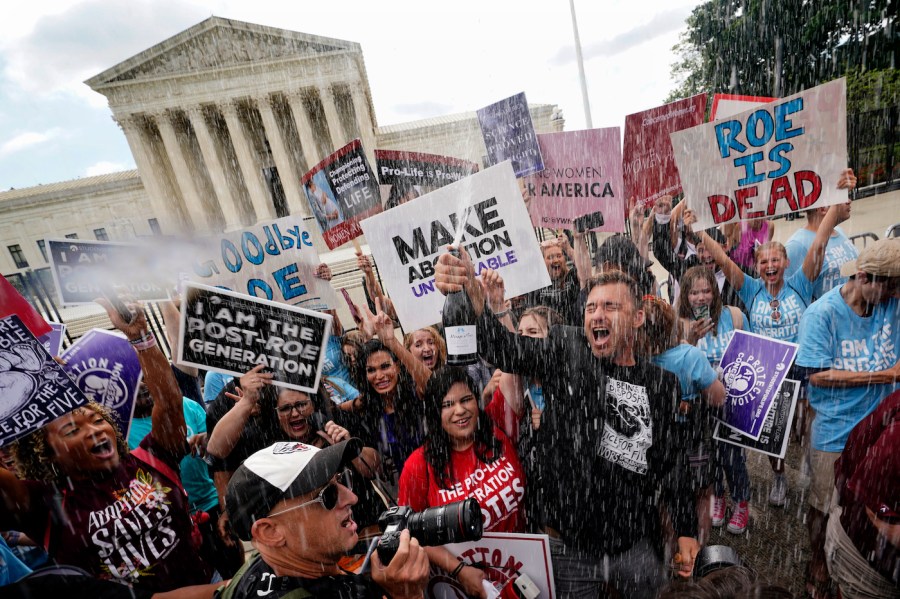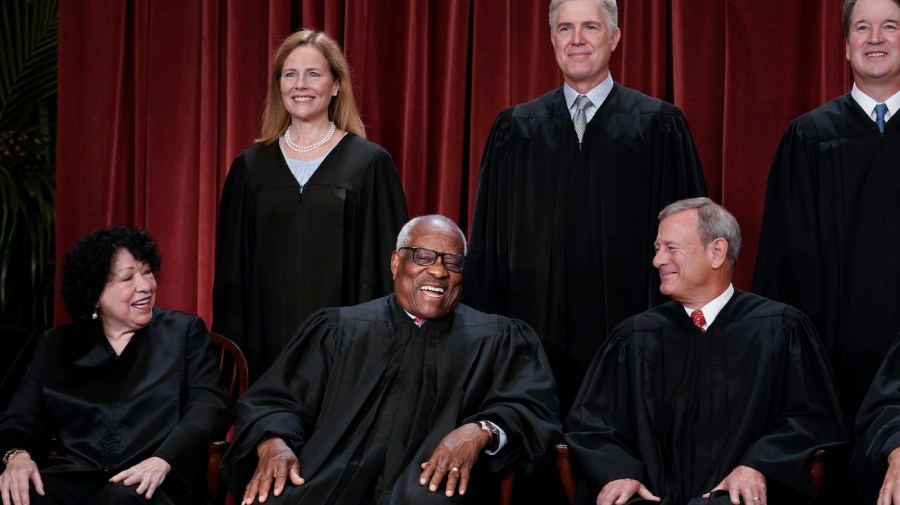The American public no longer believes the Supreme Court is impartial
Never in recent history, perhaps, have so many Americans viewed the Supreme Court as fundamentally partisan.
Public approval of the nine-justice panel stands near historic lows. Declining faith in the institution seems rooted in a growing concern that the high court is deciding cases on politics, rather than law. In one recent poll, a majority of Americans opined that Supreme Court justices let partisan views influence major rulings.
Three quarters of Republicans approve of the high court’s recent job performance. But Democrats’ support has plummeted to 13 percent, and more than half the nation overall disapproves of how the court is doing its job.
Public support for the high court sank swiftly last summer in response to Dobbs v. Jackson Women’s Health Organization, a landmark ruling that revoked a constitutional right to abortion. The decision delighted many conservatives but defied a large majority of Americans who believe abortion should be legal.

Anti-abortion advocates celebrate outside the Supreme Court in Washington on June 24, 2022, following the court’s decision to end constitutional protections for abortion that had been in place nearly 50 years. (AP Photo/Steve Helber)
Yet, partisan anger runs deeper than Dobbs. Liberals are fuming about a confluence of lucky timing and political maneuvering that enabled a Republican-controlled Senate to approve three conservative justices in four years, knocking the panel out of synch with the American public.
Judged by last year’s opinions, the current court is the most conservative in nearly a century, at a time when a majority of Americans are voting Democratic in most elections. Democrats say the court no longer mirrors society, a disconnect that spans politics and religion. All six of the court’s conservatives were raised Catholic, a faith that claims roughly one-fifth of the U.S. population.
Republicans counter that the high court’s job is to serve the Constitution, not to please the public.
“The Left was used to, for the most part, getting its way with the court,” said John Malcolm, a senior legal fellow at conservative think tank the Heritage Foundation. “Now that the Left is not getting its way with the court, they’re trying to tear it down and delegitimize it.”
Legal scholars may not care much about the high court’s popularity, but they care deeply about its legitimacy.
And what is legitimacy? James L. Gibson, a political scientist at Washington University in St. Louis, defines it as “loyalty to the institution. It is willingness to support the institution even when it’s doing things with which you disagree.”
Americans remained steadfastly loyal to the high court for decades, Gibson said, embracing it even after the powder-keg Bush v. Gore decision of 2000, which decided an election.
But then, with Dobbs, the high court suffered “the largest decline in legitimacy that’s ever been registered, through dozens and dozens of surveys using the same indicators,” Gibson said. “I’ve never seen anything like it.”
One Gallup poll, taken after someone leaked a draft of the Dobbs ruling, found that only 25 percent of the American public had confidence in the court, the lowest figure recorded in a half century of polling.
Around the same time, journalists revealed that Ginni Thomas, wife of high court Justice Clarence Thomas, had pressed state lawmakers to help overturn former President Trump’s 2020 defeat at the polls.
“The idea that you have the spouse of a Supreme Court justice advocating for overthrowing the government — sui generis, I think,” said Caroline Fredrickson, a visiting law professor at Georgetown University, invoking the Latin term for “unique.”
With the high court’s legitimacy eroding, Gibson said, the panel faces “greater institutional vulnerability to congressional manipulation.”
An unsympathetic legislature could add seats to the court, “packing” it to dilute the influence of the conservative majority. Congress could impose term limits on justices who now serve for life. Lawmakers could narrow the court’s jurisdiction, limiting its authority to hear contentious cases.
“Practically nothing about the court is free from congressional manipulation,” Gibson said. “And, man, John Roberts is aware of this.”

President Donald Trump, left, walks with Supreme Court Chief Justice John Roberts on Monday, July 22, 2019, in Washington. (AP Photo/Alex Brandon)
The chief justice has emerged as a voice of moderation on the right-leaning panel. One Gallup poll, taken in December 2021, found that 60 percent of Americans approved of how Roberts was handling his job. Roberts outpolled other A-list leaders, including the president, vice president and leaders of the House and Senate.
“He’s the justice who twice saved Obamacare,” Malcolm said. Roberts joined the court’s liberals in rejecting legal challenges to health care reform by a popular president.
“He’s the justice who said, ‘I would not have overturned Roe v. Wade,’” Malcolm said. While he joined his conservative colleagues in the majority on Dobbs, Roberts wrote in a concurring opinion that he would have preferred not to reverse the 1973 abortion decision, but instead to rule more narrowly on the case at hand.
Roberts, chief justice since 2005, has defended the court’s legitimacy in public remarks since Dobbs. Legal scholars say he is keenly aware that his court is drifting away from the mainstream of public opinion.
“I think Chief Justice Roberts cares a lot about the optics,” Fredrickson said.
In its first term with a six-person conservative bloc, the high court overturned Roe, posited a Second Amendment right to carry guns in public and restricted the government’s role in combating climate change, among other rulings.
According to a scholarly database, the Dobbs court delivered its most conservative term since 1931.
In previous decades, by contrast, “the U.S. Supreme Court has rarely been out of step with the preferences of its constituents, the people,” Gibson said. “Throughout history, the court has ratified the views of the majority, not opposed them.”
If the current court has a historical precedent, it is the Warren court of the 1950s and 1960s. The panel led by Chief Justice Earl Warren inspired mass protests with decisions that expanded civil rights and outlawed segregation in public schools.
“You ended up having ‘Impeach Earl Warren’ signs throughout the Southeast during this time,” Malcolm said.
But even the Warren court didn’t cleave the nation by political party.
“While the divisions over the Warren court may have been just as deep or deeper, they didn’t break down deeply along party lines,” said Ilya Somin, a law professor at George Mason University. “There used to be liberal Republicans and conservative Democrats.”
Over the decades, the transfer of presidential power between parties has guaranteed a steady stream of liberal and conservative appointees to maintain political balance on the court. Former Presidents Clinton, George W. Bush and Obama each appointed two Supreme Court justices in a two-term, eight-year presidency.
And then came President Trump, who collaborated with a Republican Senate to deliver three justices in a single term.
Trump’s first appointment, Neil Gorsuch, plugged a vacancy Obama had attempted to fill with Merrick Garland, now the attorney general. The Republican Senate majority blocked Garland, stalling until the 2016 election in hope that a Republican candidate would prevail. Democrats howled.
Trump’s second pick, Brett Kavanaugh, followed a more orderly process but seeded even more controversy when a congressional witness, Christine Blasey Ford, accused the nominee of sexual assault.
Trump’s third appointment, Amy Coney Barrett, arrived on the eve of the 2020 election. This time, the Republican majority chose not to await the results. Again, Democrats howled.

Members of the Supreme Court sit for a new group portrait following the addition of Associate Justice Ketanji Brown Jackson, at the Supreme Court building in Washington, Friday, Oct. 7, 2022. (AP Photo/J. Scott Applewhite)
Barrett replaced Ruth Bader Ginsburg, a liberal icon who had clung to her seat through two bouts of cancer before dying in office at 87. Liberal strategists had urged her to resign during the Obama presidency. Some progressives fault her still for not stepping down.
In the months to come, President Biden and congressional Democrats could restore the court’s ideological balance by packing it with liberals, or hobble it by narrowing its jurisdiction. But they probably won’t, legal observers say, because the Republicans could one day weaponize the same tools against the Democrats.
Far more possible, in the long term, is a bipartisan consensus to impose term limits on the court. With medical advances extending human life, high-court justices now routinely serve for 30 years. Lifetime appointment “gives them a bizarrely monarchical sort of power,” Fredrickson said.
A 2021 bill proposed 18-year terms, with the president allowed to nominate a new justice every other year.
Two-thirds of the public support term limits. But Republicans have little incentive to back legislation that, from their perspective, solves a nonexistent problem.
“There’s a good chance that, sooner or later, we will get term limits for the Supreme Court,” Somin said. “But later is more likely than sooner.”
Copyright 2023 Nexstar Media Inc. All rights reserved. This material may not be published, broadcast, rewritten, or redistributed. Regular the hill posts







